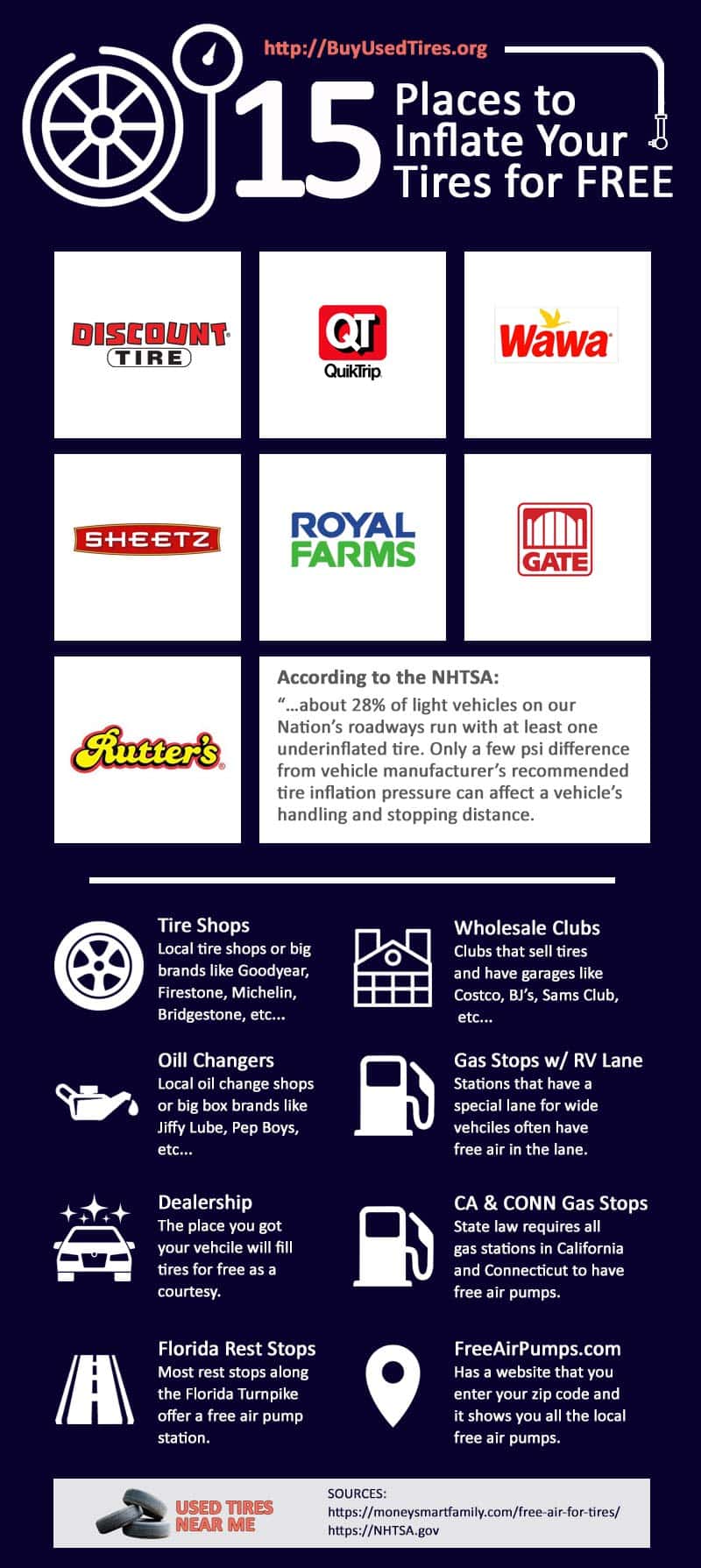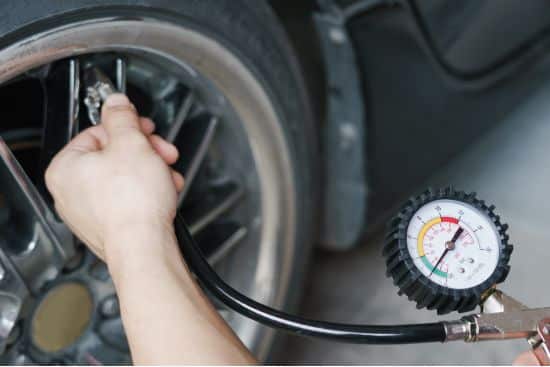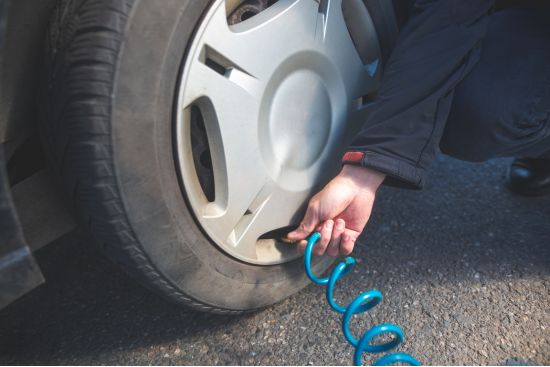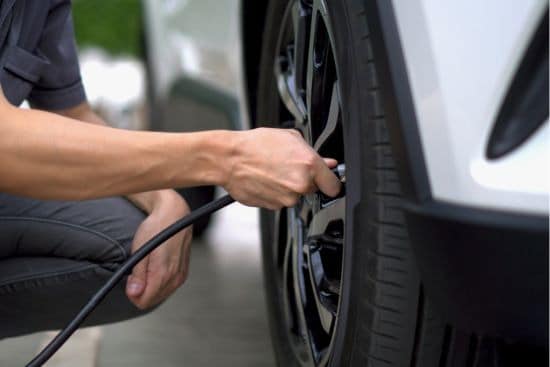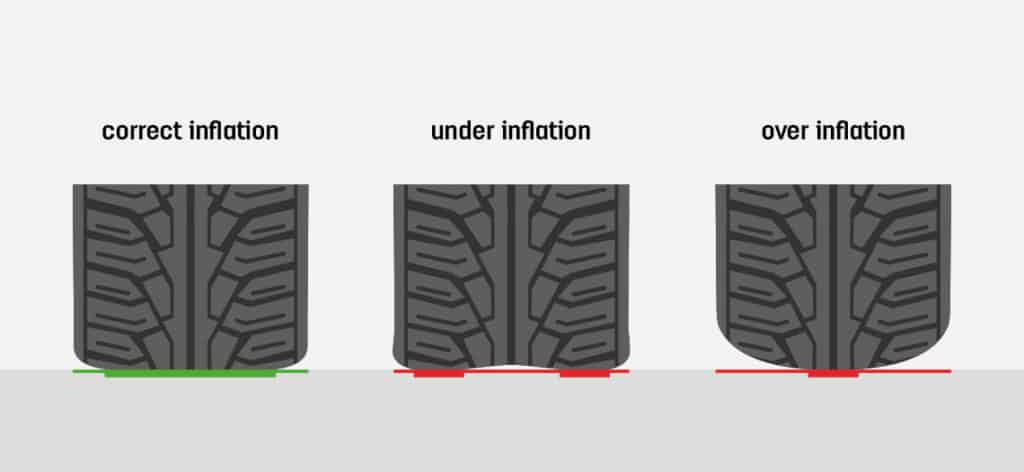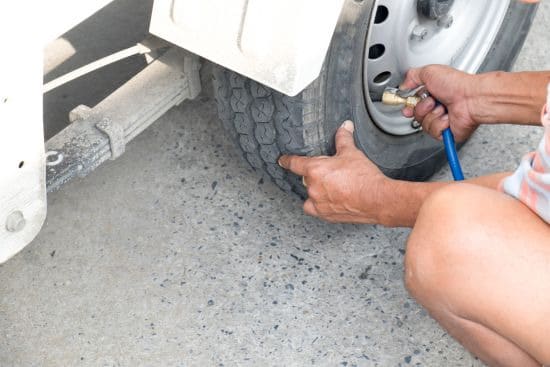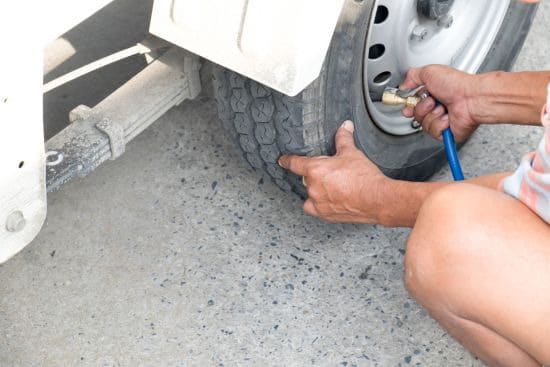It happens to everyone, you are out in your vehicle and you realize your tire pressure is low. Driving with an under inflated or low tire pressure is potentially dangerous and shortens the life span of your tire. But, do you have any loose change to use an air pump or do you want to trust swiping your credit card in one? Today I will show you where to find free air pumps, the basics of tire inflation, quick tire repair options for leaks, and share my experience with the places that have air for tires near me.
Map of Free Air for Tires Near Me
If you are looking for “air for tires near me” or “free air for tires near me”, see below for locations…
Where to Find Free Air For Tires Near Me
List of Places That Offer Free Air for Tires Near Me
If you are out looking for a free air pump near me, there are 7 specific big name stores that offer to let you inflate your tires free of charge. They are a mix of tire shops and gas stations.
Some gas stations like Shell, Sunoco, and Hess used to offer free air but have since started charging unfortunately. I’ll list them here in order of popularity and national footprint. For each location, you can click on their store finder.
Discount Tire
This tire shop chain has 1035 locations in 38 states. You don’t need to purchase tires from them, they will check your tires and fill them for free. There is a sign by the service station for “Free Air Check”. It is not a self service air station. Get in the lane and wait in line.
A technician will check your air pressure and fill your tires to the required amount. Sometimes there can be a line, so if you have the opportunity to choose when to go, avoid the weekend. Find a Discount Tire store here.
QuikTrip
This gas station has 805 locations in 9 states. If you live in Arizona, Georgia, Iowa, Illinois, Kansas, Missouri, Nebraska, Oklahoma, or Texas you can get free air. Their free air pumps do it yourself, so you pull up and pump.
The air stations are off to the side and at some stations there is more than one pump. Each air station also has a tire pressure check and bell to let you know when your tire has reached the proper PSI. Find a QuikTrip gas station here.
Wawa
is a gas station and convenience store with 800 locations in 8 states. If you live in Pennsylvania, New Jersey, Delaware, Maryland, Virginia, Washington D.C., and Florida they will have free air for your tires.
All of their 800 locations have free air. It is typically located towards the side of the building and you can also check your air pressure for free there. Find a Wawa here.
Sheetz
This chain of convenience stores has 580 locations in 6 states. If you live in Pennsylvania, West Virginia, Maryland, Ohio, Virginia, or North Carolina, you can fill your tires for free.
While Sheetz was traditionally known as a convenience store almost all of them now sell gas. The units at Sheetz are located off to the side away from the gas and at some locations, there are multiple air pumps. Find a Sheetz here.
Royal Farms
This is a small gas station chain that has 205 stores in 3 states. If you live in Virginia, Pennsylvania, or New Jersey they have free air to fill your tires. The air pumps are usually to the sides of the building and include an air pressure gauge for free as well. Find a Royal Farms gas station here.
Gate
This is a small gas station chain that has 200 locations in 4 states. If you live in Florida, Georgia, North Carolina, and South Carolina, you can inflate your tires at no cost. In my experience, Gate typically has one air pump and it’s a traditional free pump that dings when your tire meets the required pressure. Find a Gate gas station here.
Rutters
This is a small gas station with 72 locations and is exclusive to Pennsylvania. They offer free air for tire inflation at all 72 locations across the state. Find a Rutters gas station here.
Other Options For Finding Free Air for Tires Near Me
If you don’t have any of these free air locations anywhere near you, there are air alternatives you can consider if you are looking for free air for tires near me.
FreeAirPump.com
FreeAirPump.com is a resource to find other options for filling up your tires. Their site also has a map, although I find it to be kind of clunky. The good part is they show you places where you can get offers free air, for a vehicle and places where you can get free air for bicycles. It’s not a bad option in a pinch and shows a lot of places because their results are generated through crowd sourcing.
New or Used Tire Shops
Used and new tire shops will check your pressure and inflate your tires for free. This is an opportunity for them to inspect your tires and see if they can sell you new ones. Places like Goodyear, Bridgestone, Firestone, or any major brand tire shop will provide this free tire inspection service.
You are also likely to find the same at smaller tire shops in your area. It’s also good to try these places because if your tire is leaking air from a puncture you can get it patched or plugged.
Wholesale Clubs With Tire Departments
Similar to tire shops, big box wholesale stores with tire departments will also check pressure and fill tires for no cost. These are stores like Costco, BJ’s, Sams Club, etc. These chains like tire shops will use this as a potential selling opportunity. When they fill your tires they can check to see if you need new ones.
Oil Change Services
Places like Jiffy Lube and Pep Boys who perform oil changes often fill tires for free. If you are already getting an oil change then, they will fill the tires with air as a convenience to you as it’s part of their multiple point inspection.
You can call ahead or stop by and ask if they can fill your tires only without an oil change. These places generally are pretty busy and you will have to wait in line. Unlike a gas station, their air compressors are located inside the garage.
Gas Stations with Over-sized Vehicle Lanes
Some gas stations have specialty side lanes for oversized vehicles like RV’s. Typically there is a free air pump for tires in the lane. There are no rules that say you can’t pull a car or truck into the RV lane and check your air pressure and fill up your tires. Not all gas stations have this feature, but if you see one in your travels it’s often an indicator you can get free air pressure checks and tire inflation there.
Dealerships
The caveat here is not any dealership will fill your tires for free. If you happen to live near a dealership where you bought your car or is the manufacturer of your car, they might take care of you.
I had an emergency once before I got run flats on my Mercedes and I stopped by a dealership for a quick top off. Dealerships do it as a matter of customer loyalty and providing good customer service.
All Gas Stations in Connecticut and California
Both states are required by law to have free air for tires at all gas stations. Every single gas station regardless of the brand or size is required to have an air compressor free of charge for tire inflation.
Rest Stops On Florida Turnpike
Most rest stops along the Florida Turnpike have free tire inflation stations.
The Importance of Keeping Tires Inflated Properly
Proper tire inflation is key to driving performance, getting great gas mileage, and safety. Here are some of the main benefits:
- Get the most mileage out of your tires and buy less tires in the long run
- Maximize control and handling of the vehicle
- Improve stopping distance because of better traction
- Reduced risk of accidents
- Get better gas mileage and spend less on gas
- Environmental benefits to produce less waste
According to a 2009 report by the NHTSA:
“…about 28% of light vehicles on our Nation’s roadways run with at least one underinflated tire. Only a few psi difference from vehicle manufacturer’s recommended tire inflation pressure can affect a vehicle’s handling and stopping distance. Poor tire maintenance can increase incidences of blowouts and tread separations. Similarly, underinflation negatively affects fuel economy.”
Top Chains & Retailers Offering Free Air Nationally
Driving around searching for “air tires near me” can be a tiresome task, especially when your vehicle displays the dreaded low tire pressure light. Thankfully, certain chains and retailers have taken the initiative to offer air for free to their customers. Let’s dive into the top 5 chains in the country that provide this valuable service:
- Firestone Complete Auto Care:
- Description: A renowned name in the auto-care sector, Firestone Complete Auto Care has always prioritized customer service. Along with its mainstay tire and auto services, many of its locations provide free air checks and tire inflation.
- Locations: Nationwide, with a significant presence in major cities and towns.
- Specific Conditions: While air checks are free, always call ahead to confirm availability and potential waiting times.
- Just Tires:
- Description: As the name suggests, Just Tires specializes in everything related to tires. Recognizing the risks of underinflated tires, including tire related crashes and lower gas mileage, they offer air for free.
- Locations: Found across the country, especially in urban areas.
- Specific Conditions: Their free air is generally accessible during business hours. However, it’s recommended to check with the local store for any unique terms.
- Sam’s Club:
- Description: Not just a bulk shopping giant, Sam’s Club has a robust auto center. Members can benefit from services like free tire pressure checks. Plus, if you’re ever in need to inflate tires, Sam’s Club might just be your spot.
- Locations: Nationwide, predominantly adjacent to their main wholesale outlets.
- Specific Conditions: The auto services, including air checks, are mainly available to Sam’s Club members. It’s advisable to confirm this with your nearest location.
- Gas Station Chains:
- Description: Some gas station chains across the country have started to recognize the importance of offering free air spots to drivers. While not all gas stations fall into this category, chains like Hy-Vee have made a mark.
- Locations: At various Hy-Vee locations and selected other chains around the nation.
- Specific Conditions: The availability of compressed air can sometimes be contingent on making a purchase. Always a good idea to ask in advance.
- National Tire:
- Description: National Tire is another notable name in the tire industry that has stepped up to provide free air. With a strong emphasis on safety, their initiative is driven by the fact that well-inflated tires can prevent mishaps.
- Locations: Spotted in multiple states and significant urban zones.
- Specific Conditions: While they generally offer air without conditions, peak times might see some waiting. It’s wise to ring ahead.
Apart from these chains, there are other places where you might find free air. Tools like user-generated maps have been invaluable in identifying places offering free air. For those unable to locate a spot, a temporary solution might be using a bike pump. It’s not as effective as compressed air but can help in a pinch.
Furthermore, if you’re ever at a car dealership or even car dealerships for servicing or browsing, it’s worth inquiring if they offer air. Many dealerships, recognizing the value of added service, have started providing this for both potential and existing customers.
Remember, driving with the right tire pressure is not just about preventing the low tire pressure light from coming on; it’s about safety, fuel efficiency, and ensuring the longevity of your tires. So, the next time you need to top off your tires, consider these chains and make use of the free air spots available nationally.
How to Know When Your Tires Need Air?
If your tires look flat, keep losing air, show uneven tread wear on the outside edges or the tread surface, or you have a warning light in your car, you need air.
The warning light is generated by the tire pressure monitoring systems (TPMS), these typically go off when your PSI falls below the required level. New vehicles will have a TPMS, while older vehicles will not.
There is an issue to with overinflation, which will cause the tread to wear in the middle. This happens when you put too much air in your tire.
If your tire has a leaky valve or puncture, you will lose air pressure quickly. Checking your air pressure frequently will help you identify if there is a problem going on…
How to Check Your Tire Pressure
Checking your tire pressure is really simple. You just need a tire pressure gauge. All of the free air pumps near me, have a tire pressure gauge on them. Most of them are stick up sticks, which are known to be inaccurate, Ideally you want a digital reading.
PSI and Where to Find Your Required Amount
What you are measuring is the PSI which stands for pounds per square inch. The PSI needs to be inflated to the requirements of your vehicle. You can find that information inside the driver’s side door jam on a sticker or in the vehicles owner’s manual. You may also find a sticker inside your gas cap.
If you look at the numbers on the sidewall of the tire, you will see the maximum amount your tire can handle. That is not the same thing as the vehicles recommended PSI. If you over inflate the tire, you can cause a blowout.
Checking the Pressure
Ideally, you want to check the tire pressure, when the tire is cold. If you have been on the road for a while, the heat in the tire causes an increase in the pressure reading.
It’s only temporary though, but it will take a few hours for the air in your tires again to get cold. You can check the pressure, but the reading may not be precise.
To check the pressure follow these steps:
- Remove the tire valve and place it where you won’t lose it
- Place the pressure gauge directly on the air valve to get the PSI
- Take a few pressure readings and take the average of them
- Refer to the recommended PSI for your vehicle
How Often Should Check Your Tire Pressure?
Everyone has a different opinion on this, but since we are a used tire blog, we say frequently. If you are a used tire buyer, then I would say weekly for the first month you own your tires. If you have had your own tires on for a while then 3 to 6 months is fine if you don’t see or feel any issues. Proper tire inflation should be part of your regular maintenance.
You should note that several factors can influence your tire pressure though. This includes the weather, how often you drive and how far, and the load that you carry or tow. For every 10 degree drop in temperature, you lose one pound of pressure. That’s why your TPMS in your car throws more warnings in the winter.
How to Inflate Your Tires to the Correct PSI
Now that you have checked the pressure, the next step is to properly inflate them with air.
- Follow the steps above to check the pressure
- Set the PSI on the machine to the required level, around 30-35 PSI for most passenger vehicles. If the gas station air pump doesn’t have a setting, then you need to add air and then check the pressure with your own gauge.
- Firmly place the tip of the valve into the stem and listen for air flow, some machines will ding a bell when the set PSI is reached.
- Add or release air as necessary to match the recommended PSI. To release air you need to press down the pin in the middle of the valve on your tire. release air in small increments and check the pressure as you go.
- Put your valve cap back on.
All in all, it should take no more than a few minutes to inflate your tire to the manufacturer’s recommended PSI. If you find yourself adding air frequently, your tire may have a puncture or a leaky valve.
How To Fix a Tire Leaking Air
If you have a tire with a puncture, you can repair it yourself. There are products like Fix a Flat and DIY plugs and patches. Some newer cars have run flat tires, which will drive long enough for you to perform a repair. You can also buy a portable air compressor for your home or a small one for the trunk to fill your tires up for free.
If your tire has a puncture on the tread surface, you can plug or patch it. If you have any damage to the sidewall, you will want to get a new tire right away.
Where to Get a Tire Repair
If you are experiencing a tire needing frequent air, you may need to get it repaired or replaced. Your local tire shop or local mechanic are the most common places to get a repair. There are big box stores like BJ’s, Walmart, and Costco, that have tire service centers that can handle both repair and replacement.
If There I Don’t Have Free Air For Tires Near Me, What Does It Cost?
Depending on what you find, you should pay between $1 and $2 to fill up your tires. Some machines are old and only take quarters. With newer machines, you can swipe your credit card. While a few bucks doesn’t seem like much it can add up if your tire leaks air and you follow the NHTSA guidelines of adding air once a month.
If more than one tire needs air you may need to run the machine a few times. Most pay machines are set on a timer that only lasts a few minutes before you need to pay again.
Tips When Using Public Air Pumps
When it comes to ensuring the safety and longevity of your car, the importance of having the right amount of air in your tires cannot be stressed enough.
Many people often turn to public air pumps, especially if they’re looking for a place offering free air. Here are some key pointers to remember:
- Checking Pressure First: Before you start pumping, it’s essential to check the current pressure of your tires. Over-inflation can be as detrimental as under-inflation. Most public pumps have built-in gauges, but they might not always be accurate.
- Bringing Your Own Tire Gauge: Given the potential inaccuracy of public gauges, it’s a good idea to invest in a personal tire gauge. They’re compact, relatively cheap, and provide you with a precise reading, ensuring you put the right amount of air in your tires.
- Safety Precautions: Always make sure your car is turned off when you’re working on your tires. Also, avoid wearing loose clothing or accessories that can get caught in the air hose. Stay attentive to your surroundings, especially if you’re at a busy gas station or shop.
DIY Solutions: Portable Air Compressors and Home Solutions
In today’s DIY age, many car enthusiasts are looking for solutions they can access from the comfort of their homes. Here’s a dive into portable air compressors:
- Pros and Cons of Having Your Own Air Compressor:Pros:
- Convenience: No more searching for free air spots or waiting in line at a public pump.
- Accuracy: Combined with your personal gauge, you can ensure the right pressure every time.
- Multi-purpose: Good for inflating other items like sports equipment or pool toys.
Cons:
- Initial Cost: Quality compressors can be a significant initial investment.
- Maintenance: Like all equipment, they need regular check-ups.
- Storage: They require space and the right conditions to prolong lifespan.
- Top Models in the Market: While I can’t provide real-time data, as of my last update, brands like DEWALT, Makita, and Porter-Cable were among the top-rated for portable air compressors. Regularly checking reviews on trusted sites can guide your decision.
- Tips on Storing and Using Portable Air Compressors:
- Place them in a dry, cool spot to prevent any potential damage.
- Check hoses regularly for any wear or tear.
- Ensure the compressor is turned off and unplugged when not in use.
- Periodically drain the tank to remove any moisture – this prolongs the equipment’s life.
State and Local Regulations on Free Air
In many areas across the United States, the provision of free air for tires is not just a courtesy but a mandate regulated by state law. For instance, California, among a few others, has a state law requiring gas stations to offer free air, especially for those who purchase fuel.
This is essential, considering that driving on an improperly inflated tire can be as dangerous as driving on a spare tire. Nevertheless, while some establishments generously throw in perks like free car washes for customers, they might neglect the crucial obligation to provide free air.
Citizens can contribute to a user generated map online, marking stations compliant or non-compliant with this rule. If you encounter a gas station that violates this regulation, it’s vital to report it to local authorities to ensure road safety for all.
Free Air for Tires Near Me Conclusion
No matter if you have new or used tires, keeping them properly inflated is of utmost importance for performance, gas mileage, and safety. If you are tired of paying a few dollars for air pressure checks and inflation, there are plenty of free options out there to save money on.
This is good to know not only what’s around for you locally but if you are traveling and need a free air compressor for a fill up. If your tire is in need of air, you should not wait to have to find a free air compressor or pump, you need to fill it. This is a safety issue that is not worth the $1 or $2 you will spend on a paid air at local gas station.
Before filling your tire, you should understand how much air to put in, how often you should check the tire pressure, and be able to spot a leaky tire. This is what I have learned from the places that have free air for tires near me.
Frequently Asked Questions About Air Tires Near Me
Do Gas Stations Have Free Air for Tires Near Me?
Most gas stations have an automated air pump for tires. Some offer the ability to check your tire pressure and set the machine to stop when the desired PSI has been reached. There are some gas stations that offer free air for tires. Others have machines that take either coins, bills, or credit cards.
What is the Difference Between Nitrogen Air and Normal Air for Tires?
Nitrogen air is more dense and leaks at a slower rate than oxygen inflated tires. The benefits of Nitrogen include extending the life of your tire and less frequent need to inflate them. The disadvantage is that you will spend more money on inflation expenses over the life of your tire. You can find nitrogen pumps here.
Why Won’t My Tires Hold Air?
There are various reasons why a tire may not hold air. There could be a puncture caused by an object in the tire, a small piece of debris lodged between the tire and the wheel rim, or even a faulty tire valve. All tires lose air slowly over time and you should check the tire pressure when the tire is cold.
What Tire Pressure is Too Low?
For a standard passenger vehicle tire, the lowest driving pressure is 20 PSI. Anything below 20 PSI is at high risk for a blowout. You should never let your PSI go 2 points below or above the manufacturer’s recommended tire pressure. The tire pressure will vary will you are driving and the tire heats up. You should measure the pressure when the tire is cold.
